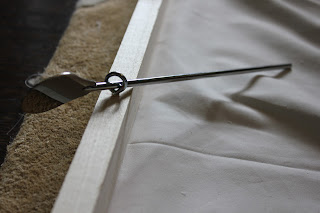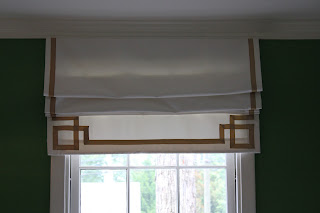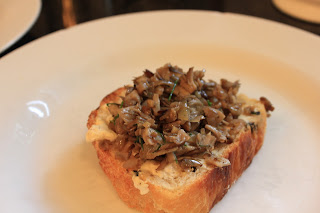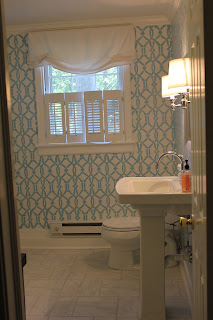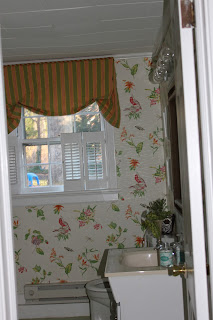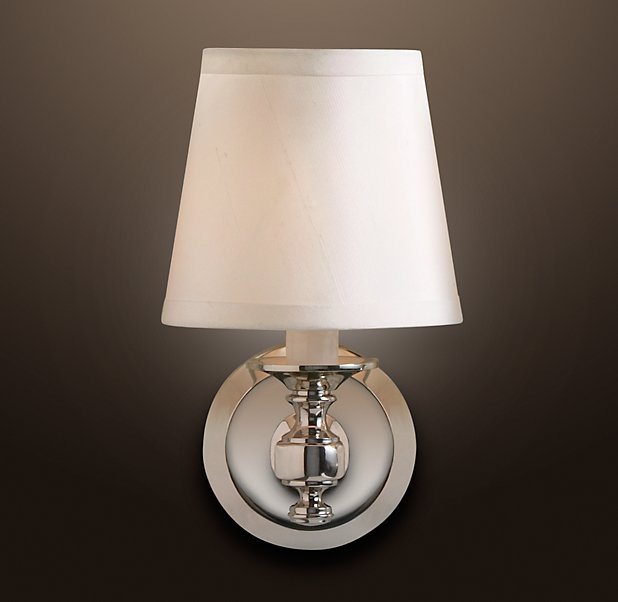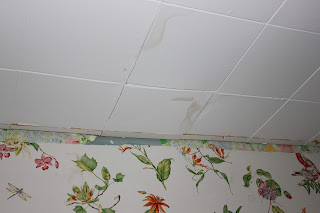It has been some time since I made these shades, but writing the tutorial has been tough! So here goes:
I wanted Roman shades for my living room, and was inspired by this photo:

Let me begin by saying that if you make these shades without trim, you can make these without a sewing machine. You would have to sew one of the sides by hand, but that is all you would need to sew (aside from attaching the rings)! Attaching trim is more complicated. I used a sewing machine. You could do this by hand, but it would take a lot of time and patience.
One of my favorite DIY curtain-making tricks is to transform a pre-made curtain panel into a different type of window treatment. I did this in our family room makeover taking white panels--which I bought for $10 a piece at Lowe's--and turning them into pleated valances. You can see this project
here. I decided to to this again for my Roman shades this time using lined panels from JC Penny's. I do this for several reasons: 1.) It is economical as you can get a lined panel for about $30; you would be hard pressed to buy the fabric separately--lining and front fabric--for that price. 2.) Most of the measuring has been done for you thus simplifying the process. 3) You won't need to hem the curtain because that has been done for you as well. 4) I didn't know it at the time, but the light-weight black-out lining that was fused to the front of the fabric makes nice folds. You will still have to "train" these shades a bit, but they will look pretty good from the get-go.
The first thing you want to do is gain an understanding of how Roman shades work. I watched these
tutorials by Terrell Designs which are available on You Tube. Even though I am not making mine exactly as she does, I found these videos useful.
Next comes measuring. You will need to know how long and wide you want the
finished shade to be. You will need to take into consideration whether you'd like your shade to be an inside or outside mount. (Watching the videos and reading the website by Terrell Designs might be helpful if you aren't sure.)
I decided on outside mount shades to cover my molding. The finished shades would be 40 inches wide and 72 inches long. My seam allowances will be 1/2 inch. So, I purchased a curtain that is larger than my finished shade would be. I bought this one from JC Penney's:
Linden Street Ellis Thermal Rod Pocket Panel in Cool White 42 x 84 inches.
Here is how I transformed my curtain to a Roman Shade:
Supplies:
- pre-made curtain panel
- trim, optional*
- pins
- scissors
- measuring tape
- sewing machine (if attaching trim)*
- needle for hand-sewing
- 2 x 1 inch board (It will really be 1 1/2 x 1) cut the desired length of shade
- 3/4 inch plastic rings, found in the curtain making section at a craft store like Joanne's
- staple gun and staples
- hammer
- thin dow rod that is almost as wide as your curtain
- screw eyes
- cord for your shades, also found in the curtain making section at a craft store like Joanne's
- tools and hardware to mount the shades: l-brackets, screw diver and screws
*These Roman shades can be hand-sewn (I truly think a beginner could do this) if you choose not to attach trim. I use my sewing machine on this project only to attach trim, and sewed the one side seam by hand.
1. First I measured the size that I wanted the finished shade to be: 40 inches wide x 72 inches long.
2. I purchased a panel curtain from J.C. Penney's that is bigger than the size (42 inches wide by 84 inches long) of what the finished Roman shade would be.
3. I cut-off the tab top as close to the seam as possible.
Now, here is what surprised me. I found that the lining was fused to the front fabric; that is, the lining and the front fabric were not separate pieces of fabric as is standard in lined curtains, so I had to change my plan a bit. I was worried that the finished result might not look quite as professional as I had hoped because some of the stitching would be visible on the backside of the curtain and would not be covered, which a separate piece of fabric lining would have hidden. However, I decided to risk-it happy in the fact that the curtains would be much simpler to make. This tutorial is based on these specific curtains from J. C. Penney's.
4. Next, I turned-under
one side of my curtain until the front of my curtain was 40 inches wide. I used pins to hold the curtain in place so that it was 40 inches wide. Pin the entire side of the curtain under so that you curtain is the desired width.
Tip: You don't need to measure all the way across your curtain each time. Once I used the measuring tape a few times to ensure that my first few pins made the shade 40 inches across/wide, I determined that the curtain should be folded under 2 1/2 inches, so I continued pinning the curtain by making the fold 2 1/2 inches.
5. After I pinned the entire side of my shade, I hand-stitched a blind hem stitch to attach the fold. Click
here to see a tutorial on how to make a blind hem stitch. I stitched all the way down the side, but stopped just short of the bottom. I stopped my stitches before I got the factory/pre-made hem on the panel. I decided that I would insert a small dowel rod (because I had a few in my workroom) here after I attached the trim and would finish the stitching at that point. The dowel rod is optional, but I think it helped to give the shade some weight.
Hand stitching:
6. Then I attached the grosgrain ribbon.
I will be honest and tell you that this did require a good bit of time and patience!
If you are making this shade without trim, skip to step #7. (Also, I have never tried this, but if you don't want to use a sewing machine but still want trim, you could perhaps use fabric glue to attach your grosgrain.)
First, I made a sketch of the design. Then I unrolled my grosgrain and pinned it to the curtain. I takes patience and lots of measuring to make the "key" at the bottom; however, patience and proper measurements are even more important when you try to match the key on the other side of the curtain. After I was finished pinning, I used my sewing machine to sew the ribbon to the curtain. I was worried that this might look unseemly from the backside since there was not a separate lining to cover it, but my thread was a light taupe which is hardly noticeable.
If the key trim looks daunting,you could attach trim straight across the bottom or line the sides and bottom in a rectangle design making it much simpler. See my
box pleat valance tutorial to see the "straight across" look.
Note: I was making two matching Roman shades and left the first, completed curtain lying on the floor so that when I made the second, so I could pull my measurements directly from the first curtain.
7. Time to attach the rings. This also takes a good bit of time to figure out what to do and then do it. I believe it took about 3 hours to sew the rings on each shade. You will need to determine how many folds you want. I knew that I wanted my ribbon or "key" design to show even when the shade was drawn, so I had to take this into consideration. (Watching the You Tube tutorials by Terrell Designs certainly helped me with this.) A good way to think of the folds is as "flaps."
I will do my best to explain how to make the flaps: The rings are attached to every other flap or the "up" part of the fold. So, for my shades, the first measurement that I determine was the distance from the bottom of the shade to my first row of rings which would create my first flap. I wanted my key design to show, so I decided to make my first row of rings at 14 inches.
The made the subsequent rows every 14 inches. In total, I had 6 rows of rings. The flaps are created between your rows of rings--the rings pull the curtain up creating the flap.. So, I had four flaps.
I hand-sewed 5 rings on each row. Make sure you sew rings close to the edges them evenly space the remaining rings. Also, make sure you go all the way through the fabric and that your thread is the same color as your curtain.
I also decided that I wanted a longer section of fabric at the top of the shade like my inspiration picture:

8. Now you will attach the shade to your board. Make sure your shade is straight and centered. Use your staple gun and start by stapling a center staple and working out to the sides. I made my curtain so it was longer than my desired finished length, so at this point, I pulled the excess fabric to the back (over the board), and I measured to make sure my shade was my desired finished length. After I stapled the fabric to the board, I cut-off the excess fabric. (See pictures below):
Alternately, I suppose you could glue your shade with super-glue though I've never tried this myself.
9. Now it is time to attach the screw-eyes. Each of my rows has 5 rings--so you'll need one screw eye for each ring. On your board--keeping in line with each column of rings--you'll screw the screw-eyes into the board. Just used your hands at first. When it becomes to hard to twist them, use a tool, like a screwdriver, to twist them into the board.
10. After attaching your shade to your board, you will need to add your cording. I think the project starts getting fun at this point, because the end is in sight. I may even have been giddy when attaching the cording! I'm sorry to say that I didn't keep the packaging for the cording, so I don't remember the size or length needed. It was Wright's from Joanne's and that is about all I can remember.
Tie the cord around the first ring on the first row. Make several knots to make sure it is secure. Thread the cording through the column of rings above until you get to the screw eye. At this point, you'll need to decide on what side you want your "pull cords." Let's say you choose the left. Take the cord through any of the screw eyes on the board to the left. Repeat this with every column of rings. In the end, you should have all your extra cording dangling from the last screw-eye on the left.
11. Now it is time to mount your shade to the wall. My husband did this, so I'm afraid I can't give you any tips. He used l-brackets and a drill and that's about all I know.
11. Last things:
*You may need to hand-stitch the hem-where your rod is inserted--closed. I didn't, but you could.
*Play around with your shade. Trim any extra cording. You can add plastic ends to your cording.
*If you have children, read about how to prevent strangulation from Roman shades.
I hope I didn't leave out anything. Good luck!
Carson




























